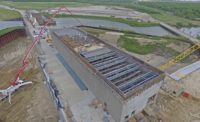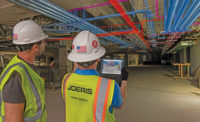ENR 2024 Texas & Louisiana | Specialty Contractor of the Year
Primoris Focuses on its Expertise and Renewables Success to Drive Growth

Primoris is currently constructing 8.3 miles of bridges for the LA 1 project, which runs 18 miles between Golden Meadow and Port Fourchon, La.
Photo courtesy Primoris Services Corp.
Primoris Services Corp.’s greatest recent success wasn’t winning a new line of business, entering a new market or anything new or creative, President and CEO Tom McCormick says. Instead, it’s the payoff of the Dallas-based company’s plan devised a few years ago to focus on improving margins, paying down debt and executing work in markets where it has expertise.
“We wanted to improve our performance, to get recognized in the markets that we’re in by not only our clients, but by our investors and our shareholders, and bring value,” McCormick says. “We’re doing it, and it’s paying off.”
That success is part of the reason Primoris was named ENR Texas & Louisiana’s Specialty Contractor of the Year. Its accomplishments from sticking to that plan can be seen in the rise of Primoris’ energy and renewables businesses, particularly in solar. When Primoris entered the ENR Top 600 Specialty Contractors list at No. 6 in 2020, its power segment accounted for just 1% of its $3 billion in revenue in 2019. On last year’s Top 600 ranking, the firm reported power had grown to represent a quarter of its $4.4 billion in revenue in 2022.
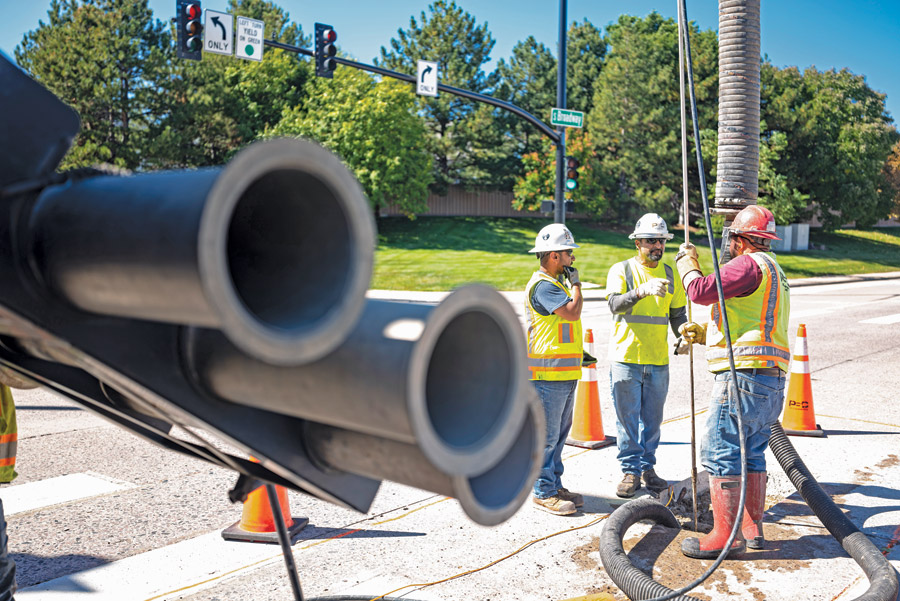
Primoris’ distribution services division focuses on gas line installation.
Photo courtesy Primoris Services Corp.
That sector is still growing. On Primoris’ latest earnings call with investors in August, CFO Ken Dodgen reported the company’s energy segment was up $194.8 million, or 25%, from the prior year thanks to solar and industrial construction work. McCormick touted how the company had booked $600 million in new energy projects during the second quarter and had already added another $500 million in work early in the third quarter.
“The thing that they have really been able to excel at is solar,” says Adam Thalhimer, who follows engineering and construction as director of research at asset management firm Thompson Davis & Co.
Solar has been an area where many contractors are struggling to make money, but Primoris has been pretty consistent at generating double-digit gross margins on solar farm projects, he says.
Increasing electricity demand for projects such as data centers, cryptocurrency mining as well as refineries transitioning to electric to run their operations means there is still plenty of work ahead in the sector, McCormick says. The Electric Reliability Council of Texas (ERCOT) updated its future demand forecast this year to project that demand in the state will increase to 150 GW by 2030 from about 85 GW this year.

The Louisiana Dept. of Transportation and Development’s LA 1 bridge project includes 18 miles of low- and medium-level bridges.
Photo courtesy Primoris Services Corp.
Last year, voters approved the creation of the $5-billion Texas Energy Fund to support development of natural gas-fueled power plants. Gov. Greg Abbott has already moved to increase the fund to $10 billion, saying in July that the state had received notices from developers indicating they would apply for $39 billion in loans from the program.
Primoris is currently working on the 72.5-MW Rocking R Solar project being developed by D.E. Shaw Renewable Investments in Caddo Parish, La., and recently completed work as the engineering, procurement and construction contractor on AES’s $245-million, 200-MW Oak Ridge solar project in Morehouse Parish, La.
Kay King, CEO of the Morehouse Economic Development Corp., says people in that community are happy with how the project turned out. “They did a good job,” she says of Primoris.
Its renewables unit also works on battery energy storage projects, and it has recently booked 800 MW of those projects across multiple states. Stephen Jones, president of Primoris’ renewables business, says the contractor is committed to continually expanding its offerings and efficiency to meet the needs of the fast-changing market.
Primoris finished its last fiscal year with its largest backlog to date, worth $10.9 billion. McCormick recently told investors he expects Primoris’ backlog in renewables will near $3 billion by the end of the year, “making us essentially booked for 2025 and establishing a solid foundation for growth in 2026 and beyond.”
“We like to go into the beginning of the year knowing that we have at least seven to eight months of backlog,” McCormick says. “If we have more than that, it’s really a positive thing.”

completed the I-220/I-20 Barksdale Air Force Base Interchange Access project, which connected the base to an existing interchange by extending I-220.
Photo courtesy Primoris Services Corp.
Facing Challenges
Working in power and utilities means Primoris has faced many of the same long lead times as other contractors for certain pieces of electrical equipment, mainly transformers and gear that goes into substations. The company is now estimating for projects that will get that equipment installed by late 2026, according to McCormick.
But Primoris has turned that challenge into a benefit. The contractor launched Premier PV, an Arkansas-based subsidiary that manufactures electrical balance of systems (eBOS) equipment for utility-scale solar and battery energy storage projects. Primoris started Premier PV as a value-add for its clients in order to avoid supply chain disruptions, and the business unit has grown to have a $55-million backlog of its own.
“We like to go into the beginning of the year knowing we have at least seven to eight months of backlog.”
—Tom McCormick, CEO, Primoris Services Corp.
“We believe that Premier PV aligns well with our strategy to expand the services we can offer our clients, and [it] has the potential to be a more meaningful contributor to our renewables profitability in the years ahead,” McCormick recently told investors.
The contractor has also faced industry labor shortages head-on by forming its own apprenticeship and training program. While many types of craft labor are in demand, McCormick says Primoris has seen the most pressure for journeyman lineworkers because it can take several years to get a fresh apprentice to the point where they can work on transmission lines with proficiency.
The training program has been so successful after just a few years that Primoris is preparing to open a larger facility in central Texas so it can train more workers.
“Our ability to deliver unparalleled service in storm recovery is rooted in our excellent training and apprenticeship programs, our immense experience and our network of skilled professionals,” says Colt Moedl, president of Primoris’ utilities segment.

Primoris served as the EPC contractor on AES’s $245-million, 200-MW Oak Ridge solar project in Morehouse Parish, La.
Photo courtesy Primoris Services Corp.
Restoring Power
The utility segment’s scope includes storm response work. Primoris sent hundreds of lineworkers to assist with power restoration efforts this year in Temple, Texas, after tornados struck the region. At the same time, the contractor also had crews working to restore power after severe storms hit the Dallas-Fort Worth area. And just a few weeks later, crews were back out making repairs after Hurricane Beryl blew through the Gulf Coast.
The experience with storm recovery work came in handy during Primoris’ work on the 82-MW Iris Solar project in Franklinton, La. Hurricane Ida damaged the region just one day before the team was ready to declare substantial completion. The contractor found 70% of the site was damaged following the storm. The team cleaned up the site and inspected all the equipment, finding it could still re-energize portions of the plant to provide power right away while crews worked to replace the damaged equipment with added safety protocols around the live equipment.
“We understand the gravity of these situations and take our responsibility to be there for our communities very seriously,” Moedl says.
Primoris also has business segments focused on areas such as industrial construction, heavy civil work and gas operations. Communications work is also becoming a larger piece of Primoris’ business as the contractor has seen increasing work installing fiber optic cable in the Southwest.
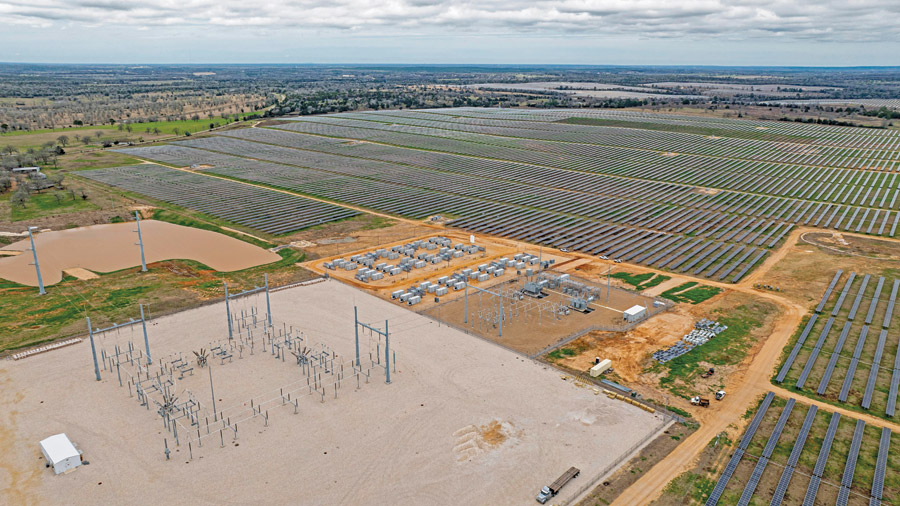
Primoris has also delivered battery energy storage sector projects, such as this one in Texas.
Photo courtesy Primoris Services Corp.
Sector Diversity Paying Off
Primoris’ heavy civil unit, previously known as James Construction Group, recently completed the Louisiana Dept. of Transportation and Development’s Interstate 220/I-20 Barksdale Air Force Base Interchange Access Project.
The work involved connecting the base to an existing interchange by extending I-220 and included construction of twin two-lane bridges over I-20 and another pair of bridges over a railroad line.
The project was complicated by the discovery of unexploded ordnance from when the site was used as a practice bombing range during World War II. The military base did not clear the ordnance on time, but the contractors were able to resequence parts of the project to avoid delays.
“The Barksdale/I-220 entrance project enhances base security, improves access for personnel and readies the base for future mission growth,” Brig. Gen. Michael Miller said in a statement at the time while he was serving as 2nd bomb wing commander at Barksdale.
Now the same heavy civil unit is the design-build contractor for Louisiana’s Jimmie Davis Bridge Replacement/Rehabilitation. The $361.7-million project is adding a new four-lane bridge over the Red River beside an existing two-lane bridge, plus widening the road on both sides of the bridge. The contractor is also rehabilitating the existing bridge to turn it into a linear park between Bossier and Caddo parishes.
The new bridge is scheduled to open by early 2027, and the full project is slated for completion in 2028. The project serves as an example of the firm’s commitment to executing complex, high-impact work, says Jeremy Kinch, president of Primoris’ energy segment, which includes the heavy civil unit.
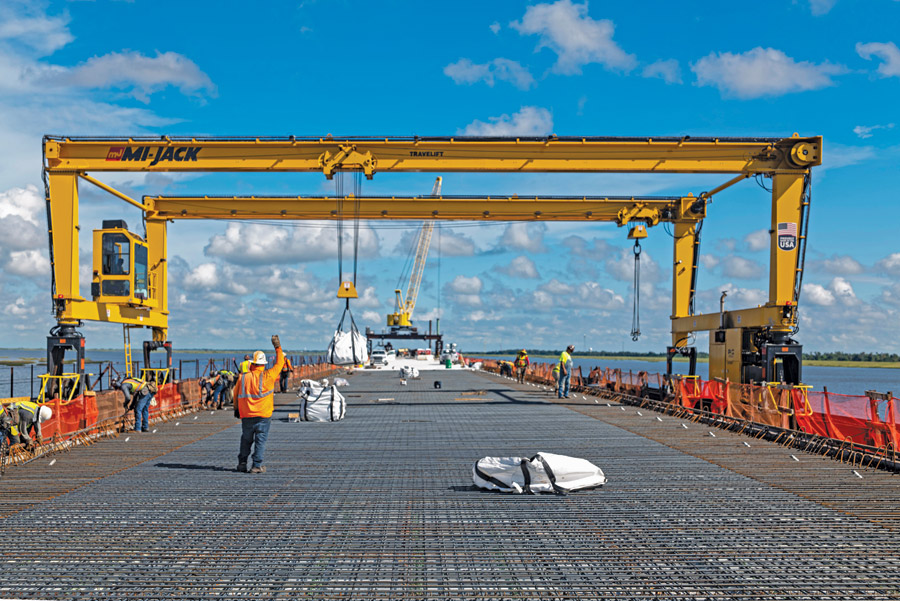
A close-up look at a Primoris crew at work on the LA 1 project in Louisiana.
Photo courtesy Primoris Services Corp.
“These projects take unique skills, thorough planning, meticulous communication and innovative approaches,” Kinch says.
The contractor has been expanding its areas of expertise as well as its client base with select acquisitions. In 2018, Primoris got into the electrical transmission and distribution sector with its purchase of Willbros Group Inc. It added communication infrastructure offerings with the acquisition of Future Infrastructure Holdings LLC in 2021 and then expanded again through the purchase of PLH Group in 2022.
When searching for acquisitions, McCormick says it’s important that the target is a contractor in one of the core competencies where Primoris is expanding and that it would bring something like new clients or territory.
The company also wants to make sure that company leadership comes with the acquisition. McCormick expects Primoris will be primarily investing in its renewables and power delivery offerings as well as in other utilities for the next five to 10 years.
“It helps you get into new markets,” McCormick says. “It also brings skilled labor to you and brings the client base. Of course, you have to demonstrate to those clients that you have the ability to do their work for them, and you have to develop those relationships.”
“The thing that they have really been able to excel at is solar. The [solar] developers trust Primoris.”
—Adam Thalhimer, Industry Analyst, Thompson Davis & Co.
McCormick points to the way Primoris builds relationships with clients as a key piece of its recent success, along with its emphasis on sticking to areas of expertise. Thalhimer, the analyst at Thompson Davis & Co., also points to Primoris’ client base as a part of its recent success. He says the contractor has developed good relationships with developers.
“The developers trust Primoris,” he says.
Working for some clients repeatedly, the contractor gets to understand their expectations and build a reputation of being dependable. That also means they’re not going to chase $1-billion projects, McCormick says.
For utility-scale solar, Primoris is usually looking at projects costing in the range of $80 million to $450 million. They generally target power generation projects valued between $200 million and $500 million, heavy civil projects from about $60 million to $460 million and heavy industrial jobs from $15 million to $200 million.
“We really want to stay in a niche because when you start getting into those big projects, you get into competition with the likes of Bechtel or Kiewit,” McCormick says. “We don’t really want to be that big and take on that risk. We manage our risk profile and try to focus on areas where we have an expertise and we know we can execute the work successfully.”



